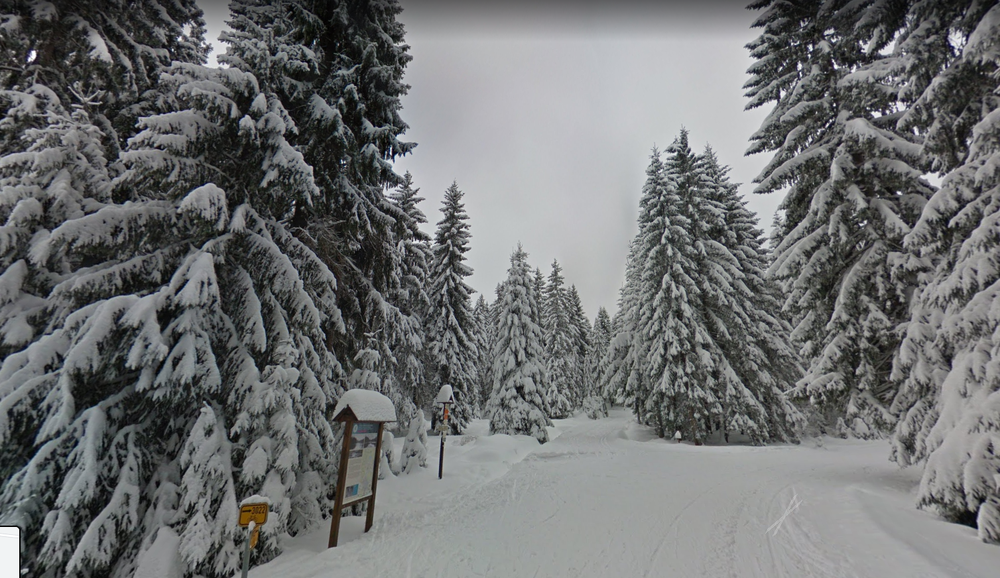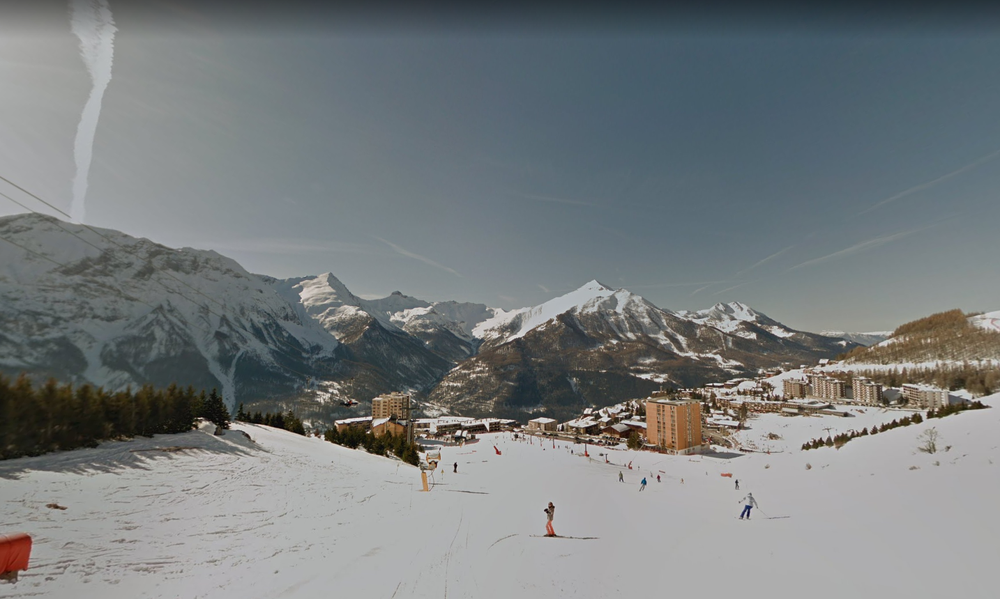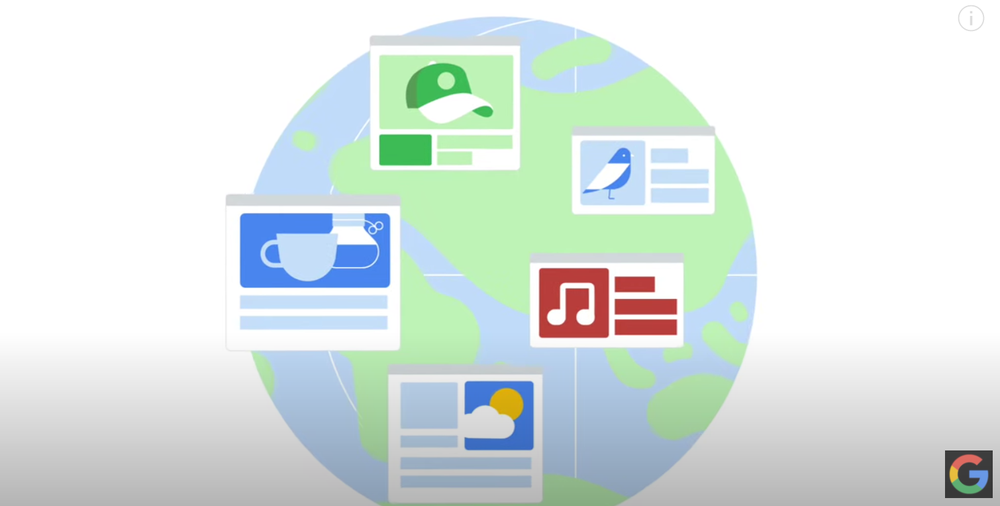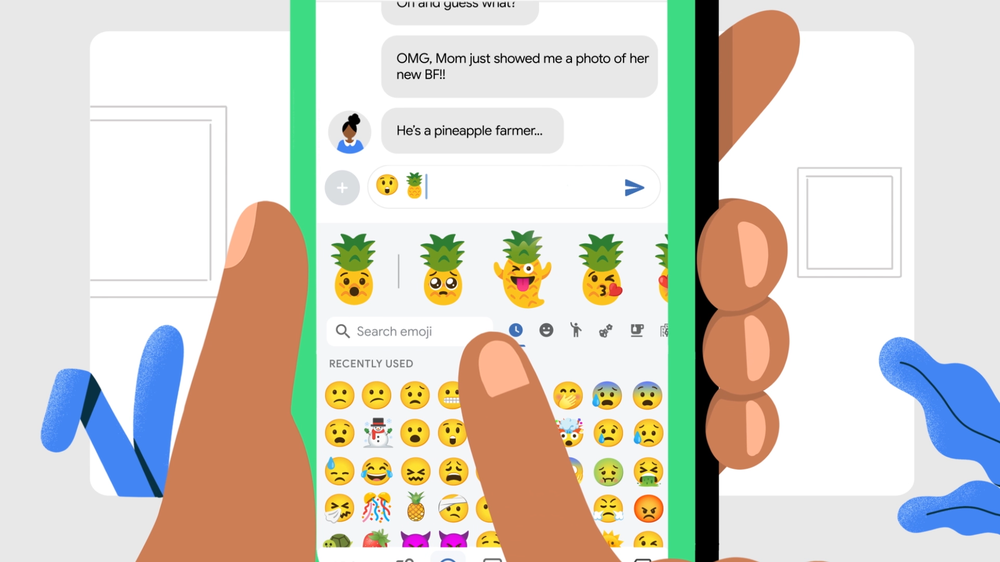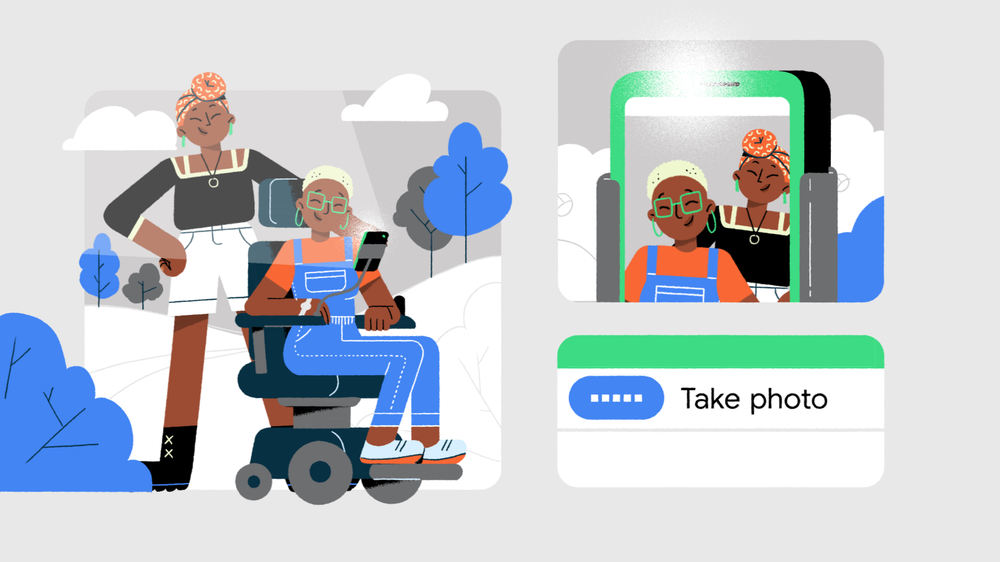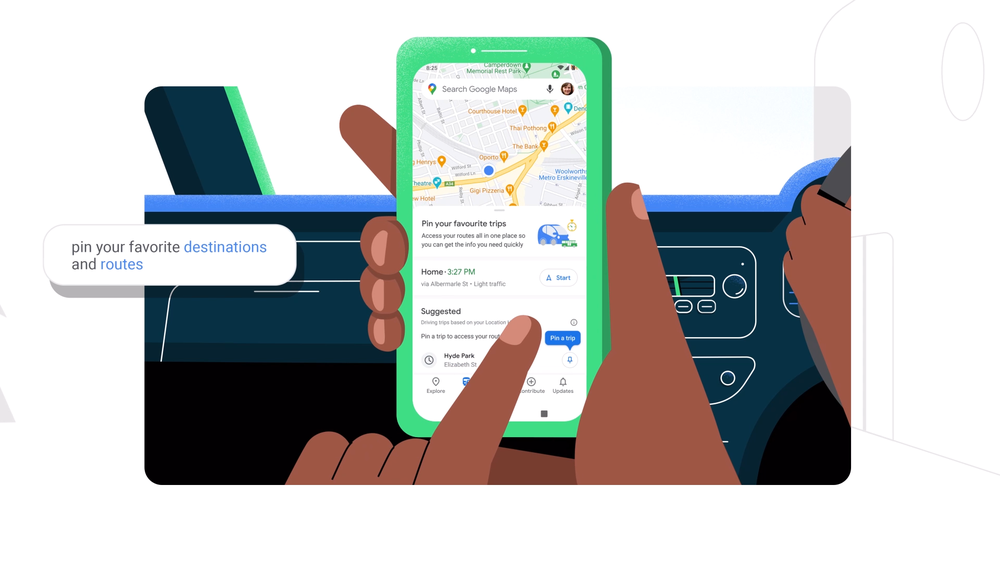Archive for December, 2020
Take a snowy stroll with Street View
by Anne Teeka on Dec.18, 2020, under 3D Models, Argentina, Australia, Brazil, California, Denmark, England, Germany, Google Earth News, Google Earth Tips, Google Sky, Google maps, Hawaii, Indonesia, Ireland, Italy, Japan, Kenya, Mexico, Natural Landmarks, Netherlands, Sightseeing, Street Views, USA
Every year when it gets colder outside,
I find myself waiting at the window wide-eyed.
I see wind and some rain, and I sometimes see ice,
But there’s one particular weather pattern that’s so seasonally nice.
It can be fluffy or sticky, and it’s often bright white,
And it’s usually the cause of a most festive fight.
When the temperature drops and the clouds look just so,
I pull out my ski jacket and get ready for—yes!—snow!
Now if you look outside and see no snowflakes in sight,
I have a travel solution that requires no flights:
You can journey to snowy lands all over the globe,
Use Google Maps Street View—you can even wear your bathrobe.
Visit this street in Norway, and imagine you hear,
The pitter-patter of strolling reindeer.
Then some miles south in Nuuksio, Finland,
You’ll see perfect snow that the Northern Lights skim.
Staying in Europe but moving farther east,
On a winter wonderland, your eyes will feast!
When you’re ready, we’ll head west to France,
And watch skiers fly down the snow in their dance.
Now if you thought things already looked cold,
Just wait until you check out the actual South Pole.
Things are much warmer for these monkeys in Japan,
They’ve got themselves a hot tub, all they need is a tan.
Thanks for joining me here, and listening to my poem,
Or perhaps, given the subject, you could call it a snow-em.
How location helps provide more relevant search results
by Danny Sullivan on Dec.17, 2020, under 3D Models, Argentina, Australia, Brazil, California, Denmark, England, Germany, Google Earth News, Google Earth Tips, Google Sky, Google maps, Hawaii, Indonesia, Ireland, Italy, Japan, Kenya, Mexico, Natural Landmarks, Netherlands, Sightseeing, Street Views, USA
There are many factors that play a role in providing helpful results when you search for something on Google. These factors help us rank or order results and can include the words of your query, the relevance or usability of web pages in our index, and the expertise of sources.
Location is another important factor to provide relevant Search results. It helps you find the nearest coffee shop when you need a pick-me-up, traffic predictions along your route, and even important emergency information for your area. In this post, we’ll share details about the vital role that location plays in generating great search results.
Finding businesses and services in your community
It’s a Friday night. You’re hungry and want some pizza delivered. If Google couldn’t consider location in search ranking, our results might display random pizza restaurants that are nowhere near you. With location information, we can better ensure you’re getting webpages and business listings about pizza places that are local and relevant to you.
The same is true for many types of businesses and services with physical locations, such as banks, post offices, restaurants or stores. Consider two people who search for zoos—one in Omaha, Nebraska and the other in Mobile, Alabama. Location information helps both get the right local information that they need:
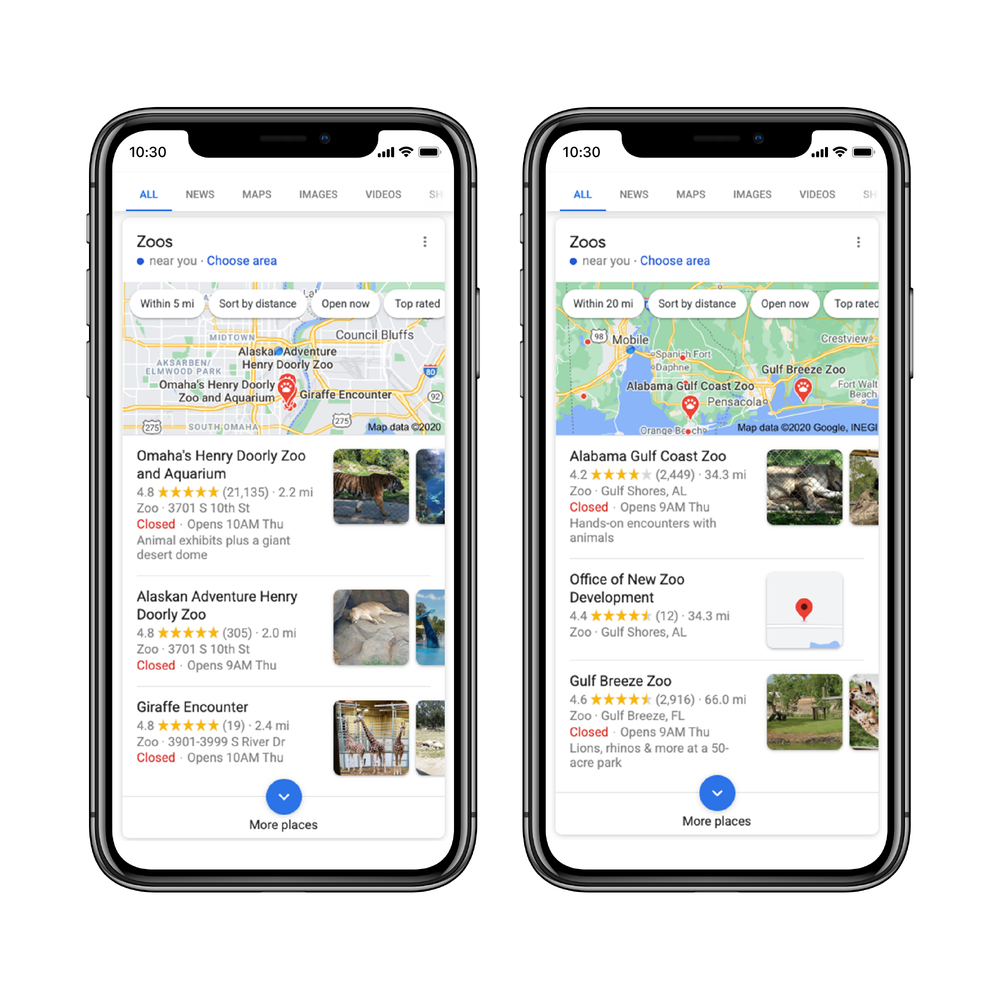
Same query, different local contexts
Location can matter even when you’re searching for something that doesn’t necessarily have a physical location. For example, a search for “air quality” in San Diego, California versus Tulsa, Oklahoma might lead you to pages with local information relevant to each area.
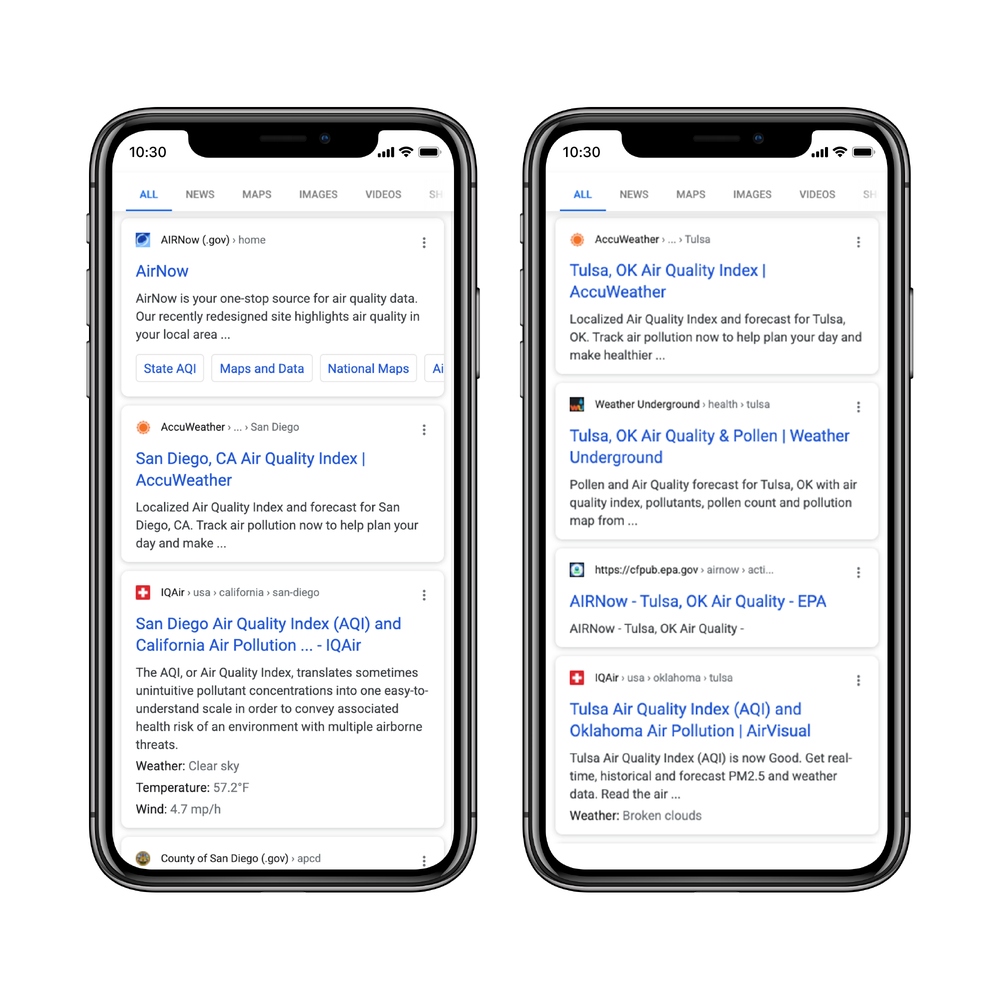
Similarly, certain information in Search can be more useful if it’s specific to your city or neighborhood. If you were to search Google for “parking information,” you might see information about municipal codes and parking enforcement for your local area that would differ from what someone else might see in another city.
Local information in search results can also be helpful in an emergency. If you search for “hurricane,” our Crisis Response features can show you local shelter information if there’s a hurricane close by, rather than just generic information about what a hurricane is.
Of course, just because some searches have local results, it’s not the case that everyone gets completely different results just because they are in different cities (or even different countries). If a search topic has no local aspect to it, there won’t be local results shown. If there is, we’ll show a mix of local results that are relevant to particular places along with non-local results that are generally useful.
How location works at Google
You might be wondering how location works at Google. Google determines location from a few different sources, and then uses this information to deliver more relevant experiences when it will be more helpful for people. Learn more about the different ways we may understand location in the video below as well as how to manage your data in a way that works best for you on our help center page about location and Search.
Location is a critical part of how Google is able to deliver the most relevant and helpful search results possible—whether you need emergency information in a snap, or just some late-night pizza delivered. For more under-the-hood information, check out our How Search Works series.
Help and how-to’s for the holidays
by Maps on Dec.17, 2020, under 3D Models, Argentina, Australia, Brazil, California, Denmark, England, Germany, Google Earth News, Google Earth Tips, Google Sky, Google maps, Hawaii, Indonesia, Ireland, Italy, Japan, Kenya, Mexico, Natural Landmarks, Netherlands, Sightseeing, Street Views, USA
Comments Off :Families, Google Assistant, Google Nest, Google TV, maps, Meet, Pixel more...Help and how-tos for the holidays
by Maps on Dec.16, 2020, under 3D Models, Argentina, Australia, Brazil, California, Denmark, England, Germany, Google Earth News, Google Earth Tips, Google Sky, Google maps, Hawaii, Indonesia, Ireland, Italy, Japan, Kenya, Mexico, Natural Landmarks, Netherlands, Sightseeing, Street Views, USA
Comments Off :Families, Google Assistant, Google Nest, Google TV, maps, Meet, Pixel more...How 15 years of mapping the world makes Search better
by Elizabeth Reid on Dec.05, 2020, under 3D Models, Argentina, Australia, Brazil, California, Denmark, England, Germany, Google Earth News, Google Earth Tips, Google Sky, Google maps, Hawaii, Indonesia, Ireland, Italy, Japan, Kenya, Mexico, Natural Landmarks, Netherlands, Sightseeing, Street Views, USA
Our Maps 101 series goes behind the scenes to share how we help you navigate, explore and get things done every single day. Over the past 15 years, we’ve provided maps in more than 220 countries and territories and now surface helpful information for more than 200 million places. These efforts bring helpful local information to your fingertips in Google Maps and produce better Google Search results, helping you connect with nearby places and businesses.
In fact, Search results that show local places and businesses now drive more than 4 billion connections between customers and businesses every month. This includes more than 2 billion monthly website clicks and other connections, such as phone calls, directions, food ordering and reservations.
Today, we’ll share more about the innovations and investments that help build an accurate and up-to-date understanding of places for the billions of people looking for local information on Search and Maps.
Maximizing Street View with breakthroughs in AI
Street View imagery lets you virtually explore the world, and helps us accurately reflect local information about places in Maps and Search. We’ve travelled more than 10 million miles across 87 countries to capture this imagery and bring new information online—from unmapped roads to new businesses.
Applying artificial intelligence to our more than 170 billion Street View images helps us create high-quality maps faster than we could before. For instance, applying machine learning models to Street View imagery has improved the accuracy of one-third of the addresses in Google Maps and Search, resulting in more reliable maps as people look for a local business or navigate to a destination.
Text recognition in the natural environment is challenging—especially at scale. The average Street View photo has visual distractions like distortions, cluttered backgrounds with extraneous text and awkward viewpoints. After years of teaching machine learning models, our text recognition systems can tune out these distractions and detect business names and addresses even when they're handwritten on the side of a building or abbreviated. These models can understand a variety of languages across various scripts too, from Latin, Cyrillic and Thai to Chinese, Japanese and Korean.
In the last few years alone, processing imagery with AI has been one of the important ways we’ve been able to add more than 10 billion edits to our library of places, providing people with updated phone numbers, business hours and locations as they use Maps and Search.
Building data partnerships with authoritative sources worldwide
Thanks to partnerships covering more than 10,000 local governments, municipal agencies and organizations around the world, we're able to reflect the latest information in Search and Maps results and help local authorities reach even more people in their communities with important updates. This includes everything from bike lanes and road closures to the addresses of hospitals and food banks. Our teams vet each authoritative data source to make sure it’s accurate before it appears on Search and Maps.
Working with authorities around the world also helps us quickly gather and surface critical information. This year, these partnerships made it possible to make important updates relevant to COVID-19. When you search for “COVID test” on Search and Maps we now show you more than 17,000 COVID-19 testing centers across 20 countries and all 50 U.S. states. You can also see important details like if appointments are required, who can get tested and if there’s drive-through testing.
These details are crucial and accuracy is key, which is why we lean on authoritative sources to help us surface this information in Maps and Search.
A global community contributes to make Search and Maps better
To ensure our products reflect the real world as fast as it changes, we enable people everywhere to contribute their local knowledge. Every day, people make millions of contributions to Google Maps, like reviews, photos, address updates and more. And we’re seeing more people contributing than ever before. In the past 3 years, the number of reviews, ratings and photos people have added to Google Maps more than doubled.
With local details from people in Maps and Search, it’s easier to make more informed decisions. You can quickly find reviews when looking for a mechanic, see photos others have added for a park you’d like to explore, and find your convenience store’s new hours.
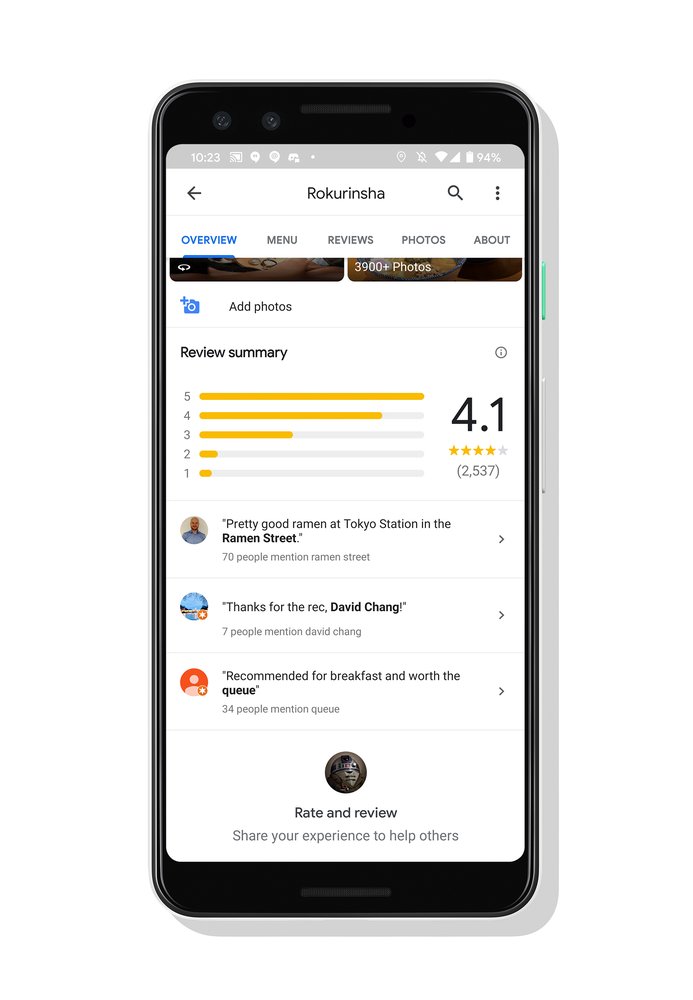
People’s reviews on Maps and Search make it easier to discover new places and learn about businesses nearby.
This year, as cities and countries instituted restrictions throughout the pandemic, many places temporarily closed or changed their operations. While businesses can indicate if they are open with their Google My Business listing, we’ve also made it easy for anyone to mark a business as open or temporarily closed on Search and Maps by simply suggesting an edit. Over the course of the pandemic, people have submitted millions of temporary closure and reopen reports, helping eliminate the uncertainty about which businesses are open and when.
Giving business owners free tools to connect with customers online
One of the most important ways we help local businesses succeed is by connecting them with customers online. Business owners can claim their free Business Profile and connect directly with customers across Search and Maps via phone calls, messages and reservations. They can also share accurate information about their business, including opening hours, services offered and contact information. And each month Google connects people with more than 120 million businesses that don't have websites, helping small business owners who aren’t online attract more customers.
Over the last five years, we’ve made more than a thousand improvements to Business Profiles, making it easier for merchants to connect with customers and share updates online. We recently made this even easier by adding new ways for merchants to view and update their Business Profile directly from Search and Maps.
With the pandemic causing daily disruptions worldwide, Google has helped businesses keep customers updated about everything from new services to adjusted store capacity and hours. Since the start of COVID-19, businesses made nearly 700 million edits to their Business Profiles, about double the number of changes made during the same time last year.
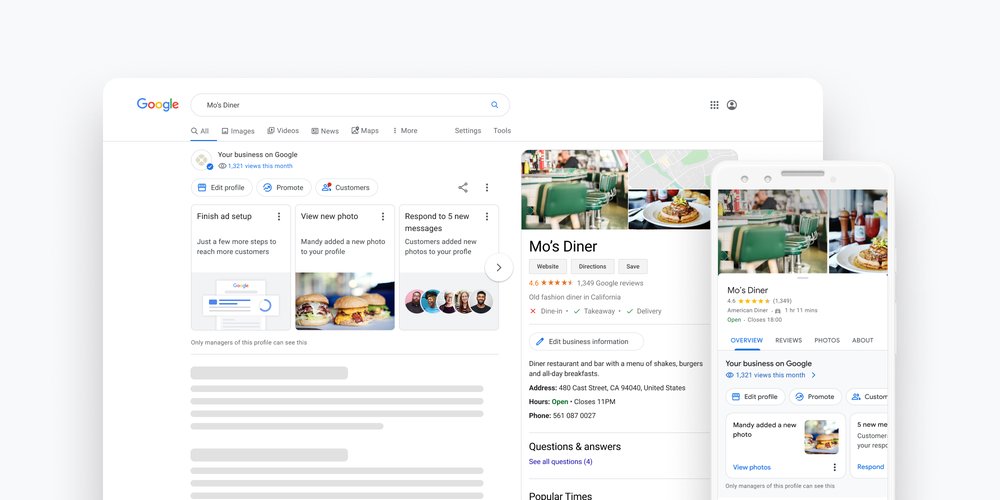
It’s easy for a business owner to update their Business Profile and engage with customers directly from Search and Maps.
Gathering local information in totally new ways
To help people find what they need in a world that changes by the minute, we’ve developed new ways to find and surface information.
For example, people tend to avoid crowded stores and long lines—and this has been especially true during the pandemic. Popular times and live busyness information help people see how busy a place tends to be at a specific time or at that very moment. Gone are the days of guessing the best time to go grocery shopping! We’re expanding live busyness information to millions of places globally and to include essential places like gas stations, grocery stores, laundromats and pharmacies.
Google’s conversational technology, Duplex, has helped us scale our ability to confirm updated information for places. Since the beginning of the pandemic, we’ve put Duplex to work making calls to businesses in eight countries—from New Zealand to the United States—to confirm things like opening hours or whether they offer takeout and delivery. This has helped us make millions of updates to business information that have been seen more than 20 billion times in Maps and Search.
Building the most helpful map of an infinitely detailed world
Beyond the technologies we’ve developed, our global operations teams play a role in nearly every aspect of mapmaking. They gather data, train machine learning models that help us index information from imagery, fix problems and evaluate authoritative data sources. They also build and maintain the automated systems that protect people from fake contributed content and even help small business owners set up Google My Business accounts.
All this to say, our work to organize the world's information and make it accessible and useful is never done. Given the pace of change, there’s never been a more important time for us to be helpful.
6 new ways Android can help this holiday season
by Ajay Gokhale on Dec.04, 2020, under 3D Models, Argentina, Australia, Brazil, California, Denmark, England, Germany, Google Earth News, Google Earth Tips, Google Sky, Google maps, Hawaii, Indonesia, Ireland, Italy, Japan, Kenya, Mexico, Natural Landmarks, Netherlands, Sightseeing, Street Views, USA
With the holidays around the corner, we’re sharing six new Google features for Android—a few more ways your phone gets more helpful over time, even outside of major OS updates. Whether you’re texting holiday greetings to loved ones or winding down with a book, here’s how Android can help.
1. Mix up more of your favorite emoji
With Emoji Kitchen on Gboard, people have mixed their favorite emoji into customized stickers over 3 billion times since it was released earlier this year. With this latest update, Emoji Kitchen is going from hundreds of unique design combinations to over 14,000. Each mix makes it easier for you to express yourself with a little extra flair. Now you can simply tap two emoji to quickly see suggested combinations, or double tap on one emoji to reveal some more intense emotions.
Already available on Gboard beta, the new version of Emoji Kitchen will be available on Android 6.0 and above over the coming weeks. Download Gboard on Google Play to enjoy the new emoji kitchen stickers this holiday season. ❄️️⛄️
2. Enjoy more stories as audiobooks
The holiday season is the perfect time to wind down and catch up on some books, and audiobooks make it even more convenient to immerse yourself in a story. But not all books, like the one written by your favorite indie author, are converted into an audiobook. Now Google Play, working with publishers in the U.S. and the UK, will use auto-generated narrators so books without audio versions can be narrated—meaning you’ll have more audio titles to choose from on Play Store. The publisher tool to create auto-narrated audiobooks is currently in beta, but it will roll out to all publishers in early 2021.
3. Use Voice Access to navigate your device
Built with people with motor disabilities in mind, Voice Access lets you control your phone using your voice. Now using machine learning technology, you can add labels to the screens of your Android apps to help you work within them with your voice. For example, you can say “open Photos”, “tap Search”, “tap Your Map” to see a map of all your photos. This makes navigation convenient and hands-free, using just your voice. Previously rolled out on Android 11, this new version of Voice Access is now available globally on all devices running Android 6.0 and above. You can download Voice Access on Google Play and try the new version out by joining the Beta today.
4. Get around with the Go Tab
With the new Go Tab in Google Maps, you can more easily navigate to frequently-visited places with just one tap. Pin your favorite driving destinations like school or a grocery store to quickly see directions, live traffic trends, disruptions on your route, and an accurate ETA—all without typing the place’s address. If you take public transit, you can pin specific routes, which will let you see accurate departure and arrival times, alerts from your local transit agency, and an up-to-date ETA right from the Go Tab. You can even pin multiple routes (including a driving route and a transit route) to the same destination to see which one will get you there most efficiently. The Go Tab starts rolling out on Android and iOS in the coming weeks.
Be sure to check out other helpful Google Maps features on Android, like live transit crowdedness and Assistant driving mode to help you navigate and get things done this holiday season.
5. Android Auto expands to more countries
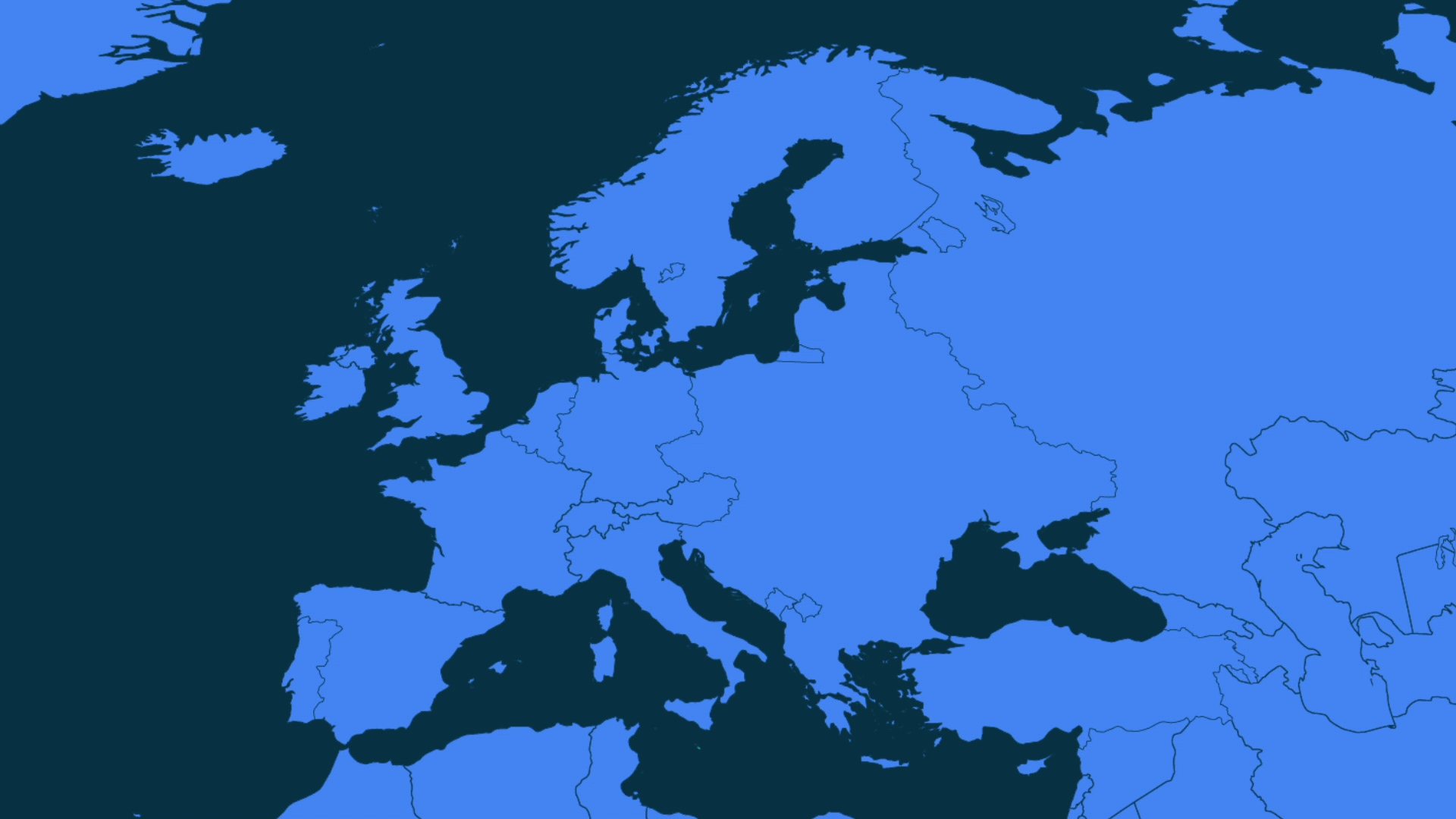
Over the next few months, Android Auto will be expanding to new countries, bringing your favorite apps and services from your phone onto your car display. With Android Auto, you can talk to Google to play music, send messages, get directions, and more, so you can keep your eyes on the road and your hands on the wheel. With phones running Android 10 and above, all you need to do to get started is plug your Android phone into a compatible car. For Android 9 and earlier phones, you can download the app.
6. Share your favorite apps with Nearby Share
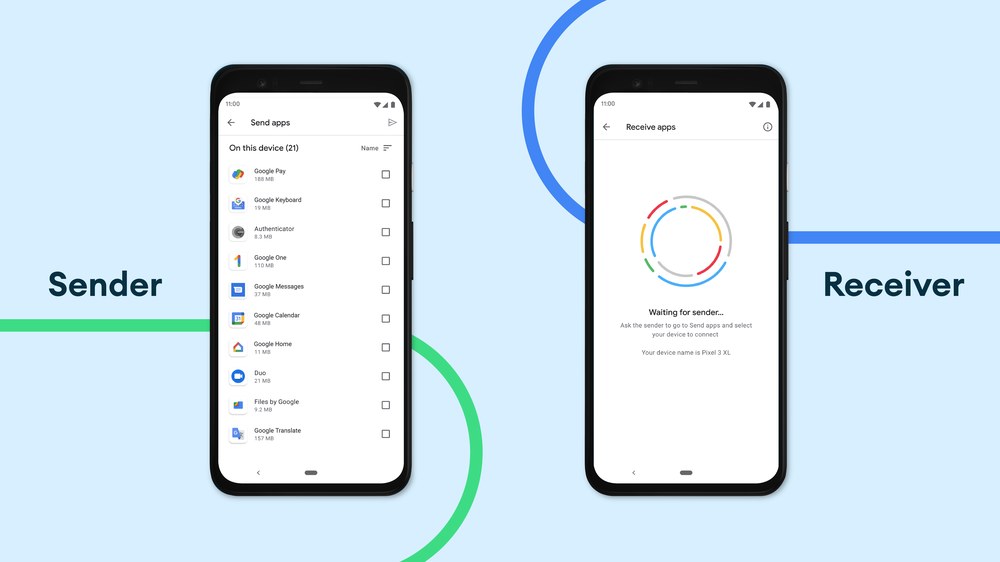
An upcoming update to Nearby Share will let you share apps from Google Play with the people around you with an Android phone, even if you don’t have a cell or Wi-Fi connection. Simply open Google Play, go to the “Share Apps” menu in “My Apps & Games,” select the apps you want to share, and let your friend accept the incoming apps. This update will roll out in the coming weeks.
Now anyone can share their world with Street View
by Stafford Marquardt on Dec.03, 2020, under 3D Models, Argentina, Australia, Brazil, California, Denmark, England, Germany, Google Earth News, Google Earth Tips, Google Sky, Google maps, Hawaii, Indonesia, Ireland, Italy, Japan, Kenya, Mexico, Natural Landmarks, Netherlands, Sightseeing, Street Views, USA
When people find out that I work on Street View, the first thing they ask is, "How can I drive the Street View car?" Sadly, we don’t loan out those iconic vehicles, but what if any car could become a Street View car? Better yet, what if anyone could contribute to Street View, using only their phone?
With our updated Street View app on Android, it’s now easier than ever to collect your own Street View imagery and put it in the right place on Google Maps. Using our new connected photos tool in the app, you can record a series of connected images as you move down a street or path.
These images are captured using ARCore, the same augmented reality technology we use to produce experiences like Live View. After you record your images and publish them via the Street View app, we automatically rotate, position and create a series of connected photos. We then place those connected images in the right place on Google Maps, so your new Street View can be found in the exact location where it was taken for others to see and explore.
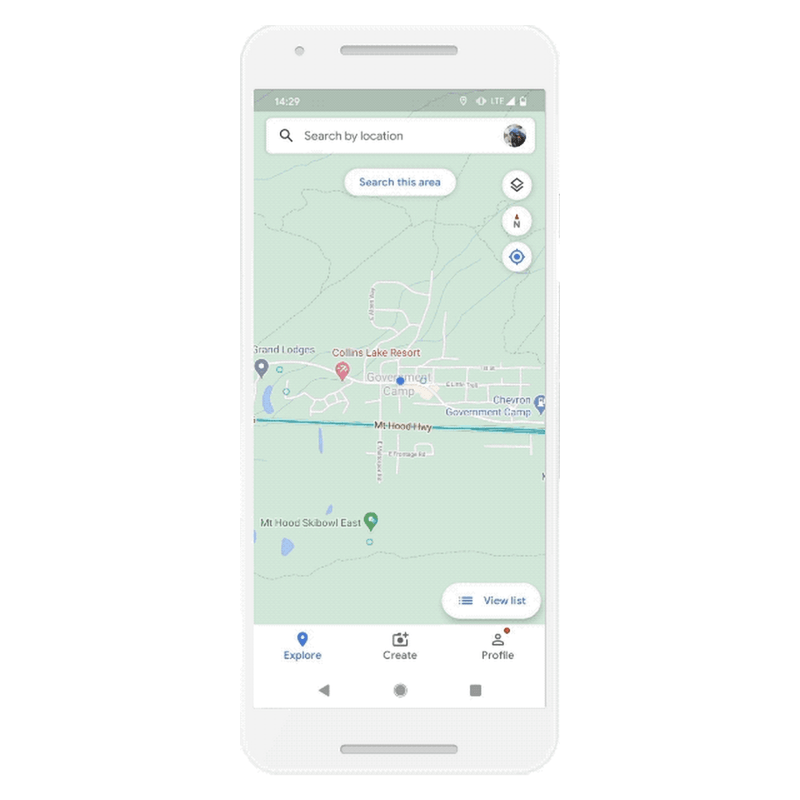
You first record your connected photos in the Street View app as seen in this example from Government Camp, Oregon. These photos were recently captured by the blog author.
Before this feature, you would typically need special 360-degree cameras to capture and publish Street View imagery. Some equipment you could even attach to the roof of your car, but at the cost of thousands of dollars; that’s out of the realm for many.
Now that anyone can create their own connected Street View photos, we can bring better maps to more people around the world, capturing places that aren’t on Google Maps or that have seen rapid change. All you need is a smartphone—no fancy equipment required.
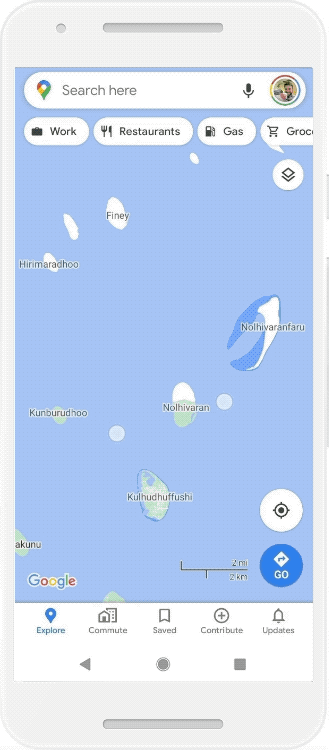
You can see Street View connected photos in the Google Maps app or on a desktop. Here's a contribution from the Maldives.
Reflecting more places and communities on Google Maps
While our own Street View trekkers and cars have collected more than 170 billion images from 10 million miles around the planet, there are still many unmapped parts of the world. That’s why for years we've been building new ways for people to contribute their own imagery to Google Maps. In fact, we've seen millions of Street View images contributed from people in every country on Earth, from Bermuda and Tonga to Zanzibar andZimbabwe.
Where people contribute connected photos, they will appear in the Street View layer on Google Maps as dotted blue lines—simply drag Pegman around to find them. Where we have existing Google Street View imagery, we’ll show that as the primary Street View experience with a solid blue line. While it’s still early days for this beta feature, there are already examples of people adding their own connected photos—from Nigeria to Japan and Brazil.
As with our other imagery, these pictures will help make Google Maps more accurate and up-to-date for everyone. For example, we can use the information in Street View imagery to update Google Maps with details like the names and addresses of businesses that aren’t currently on the map and maybe even their publicly posted open hours. We’ll also give these connected photos the same privacy controls, including face and license-plate blurring treatment that you see in the regular Street View photos that Google captures. We also make it easy for people to report imagery and other types of contributed content for review.
Anyone can contribute to Google Maps and Street View
Driving through a town where Street View cars have never been? Your phone is now all you need to tell Google Maps what's there—and let people around the world explore it through your lens.
The connected photos beta feature is now available for people using the Street View app with an ARCore-compatible Android device in Toronto, Canada, New York, NY and Austin, TX, along with Nigeria, Indonesia and Costa Rica—with more regions on the way soon.
Prepare for medical visits with help from Google and AHRQ
by Dave Greenwood on Dec.03, 2020, under 3D Models, Argentina, Australia, Brazil, California, Denmark, England, Germany, Google Earth News, Google Earth Tips, Google Sky, Google maps, Hawaii, Indonesia, Ireland, Italy, Japan, Kenya, Mexico, Natural Landmarks, Netherlands, Sightseeing, Street Views, USA
When patients prepare for a medical visit, they're more likely to have a high quality, efficient encounter and better physical and mental health outcomes. Starting today, we’re piloting a new tool that helps people prepare for visits by surfacing common questions they may have about their care--available when people find a local doctor’s office or hospital on Search.
Built in collaboration with the Agency for Healthcare Research and Quality (AHRQ), part of the U.S. Department of Health and Human Services, our tool helps people build a visit plan by selecting from evidence-based questions like, “What is this test for?” as well as adding their own questions. When they’re finished, they can print or email the visit plan and bring it to the doctor’s office to help them remember important questions they want to ask. The visit plan also includes a reminder of things patients should bring to the visit, like a list of current medications, recent lab results, and their insurance card. The tool is private and secure: Google does not store any of the information.
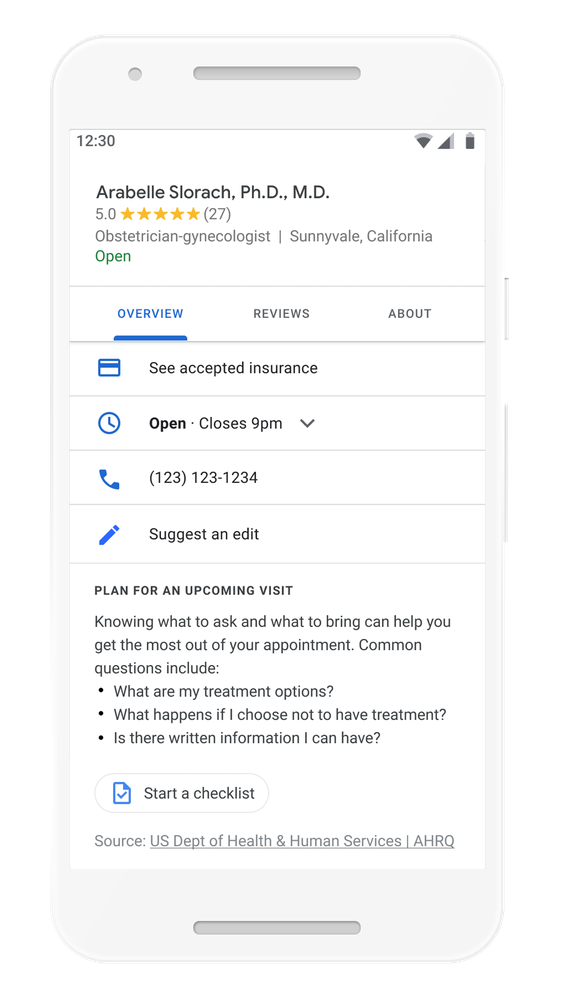
Ten questions for more engaged care
The suggested questions, developed by AHRQ as part of its “Questions are the Answer” initiative, are designed to get people thinking about their goals and priorities for the visit. They’re based on findings from dozens of patient safety research projects as well as AHRQ’s expertise on diagnostic testing and results, medication safety, safe transitions between care settings, and the importance of patient and family engagement in healthcare.
“Patients who prepare for medical visits by prioritizing their questions, strengthen their role as members of their own health care team,” said Jeffrey Brady, M.D., M.P.H., a preventive medicine physician and Director of the Center for Quality Improvement and Patient Safety at the AHRQ. Dr. Brady added, “This helps clinicians maximize their time with patients so they can better address their most critical health needs. Clinicians appreciate that healthcare can be more efficient, effective, and higher quality when they work together with patients.”
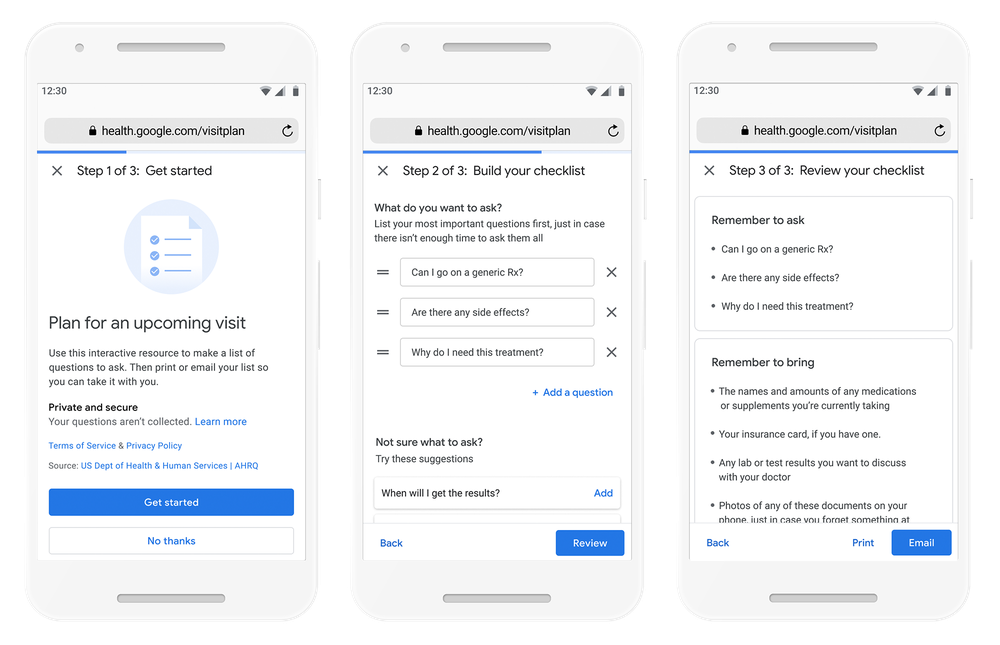
Protecting health information
People come to Google for health-related information every day, and we’re committed to helping them get the information they need along their healthcare journey. The tool does not gather any personal health information or store any of the information that is entered into the tool. People have the option to print or email their visit plan, and people can use this tool without signing into a Google account. This tool is in a pilot phase and is currently available to a limited number of people in the United States and will expand to more users over time.
Healthcare can be confusing and overwhelming, but simply thinking about goals before meeting with a clinician can have a huge impact on patient experience and health outcomes. With the visit planning tool, we hope more people will effectively plan for medical visits, get more out of their visits and ultimately achieve better health outcomes.
New ways to connect with and understand your customers
by Aditya Tendulkar on Dec.03, 2020, under 3D Models, Argentina, Australia, Brazil, California, Denmark, England, Germany, Google Earth News, Google Earth Tips, Google Sky, Google maps, Hawaii, Indonesia, Ireland, Italy, Japan, Kenya, Mexico, Natural Landmarks, Netherlands, Sightseeing, Street Views, USA
When people look for information online, they want to find the answers to their questions quickly. This is especially true for people browsing nearby businesses. Business Profiles help merchants share information like how late you’re open and what safety measures are in place. But sometimes people are looking for answers to more niche questions such as: “Do you make gluten-free cakes?” or “Is there covered parking?”
To help you quickly answer these questions and connect with the people who are interested in your business, we’re bringing messaging capabilities and customer insights directly to you on Google Maps and Search.
Messaging with customers just got easier
Earlier this year, we made it easier for you to update your Business Profile directly from the Google products you’re already using—Maps and Search. Now, you can access even more features from these products so that you can engage with customers and update your business information from the same place.
Starting today, we’re rolling out the ability for verified businesses to message with customers directly from the Google Maps app. Once you turn messaging on from your Business Profile, you can start replying to customers on Google Maps from the business messages section in the “Updates” tab. And soon you'll also be able to see your messages right from Google Search (via the Customers menu on your Business Profile) and message customers directly from your computer.
If your business uses a messaging partner, you can sign up to access the Business Messages API and take a look at our developer guide.
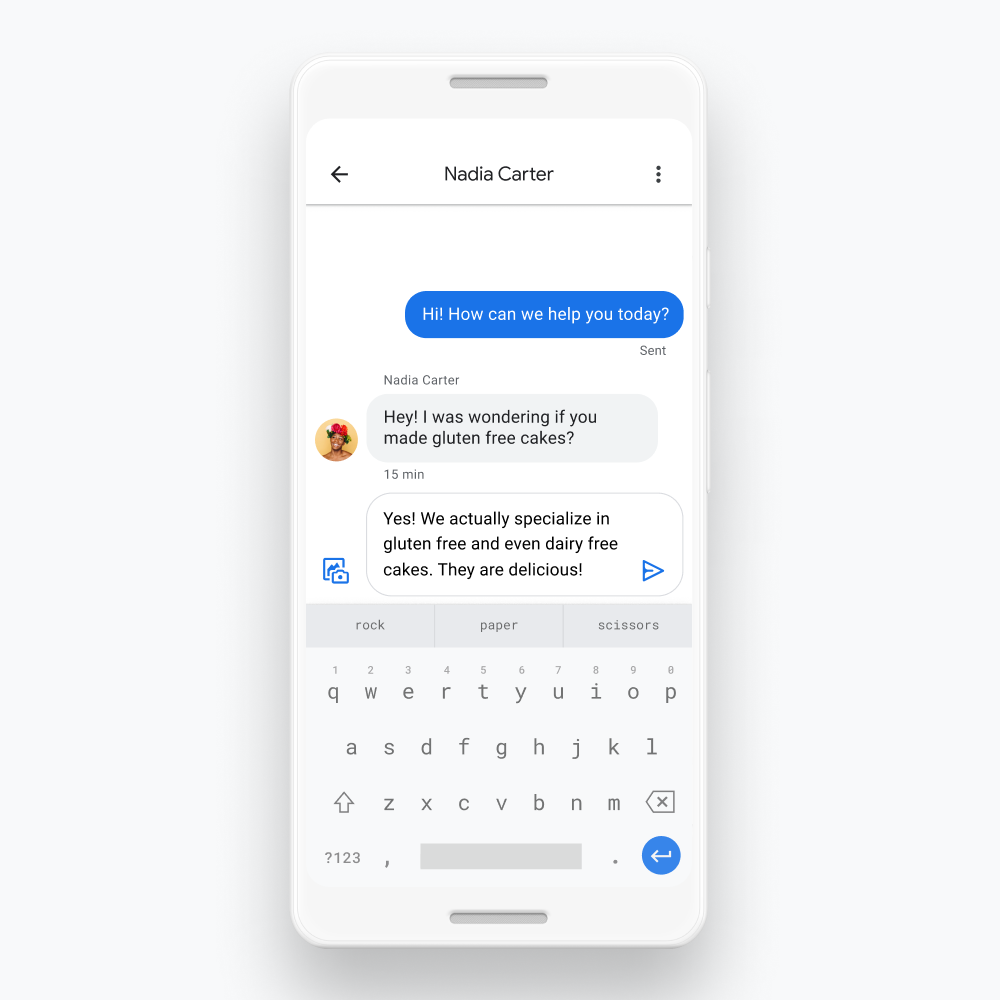
You can now respond to customer messages straight from the Google Maps app
As more people try to make more informed decisions before leaving the house, we’ve seen an uptick in the number of messages sent to businesses. Since the beginning of this year, people have initiated more than twice as many messages to merchants right from Business Profiles on Search and Maps.
To make it even easier for customers to get the information they want from businesses, we’re adding more ways for people to initiate messages with you. In addition to clicking on the “Message” button on your Business Profile, customers can now start a conversation from any post you create. And if they try calling and you don’t answer, they will be prompted to send a message.
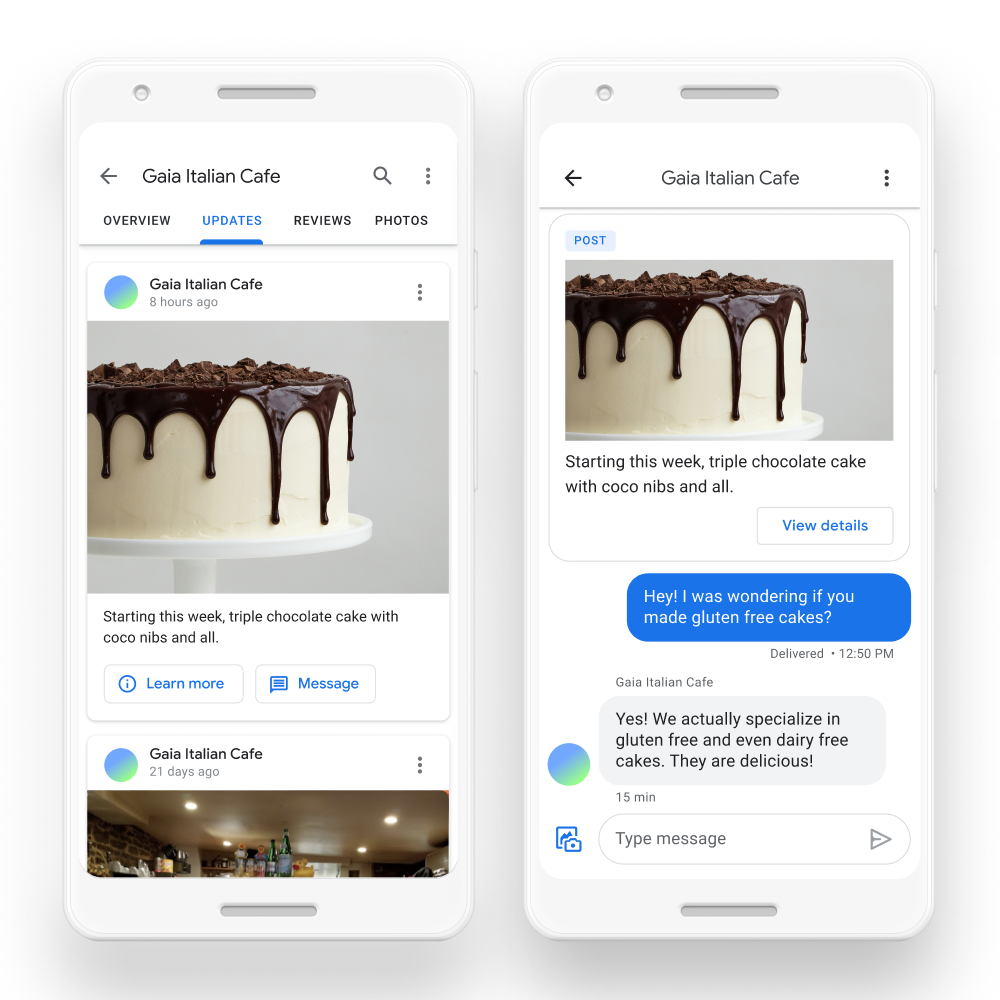
Customers can now message you directly from any posts you create
Learn more about your business with updated performance insights
This summer, we rolled out updated performance insights on Search and Maps that give you a detailed report of your customer interactions. The report includes the total number of interactions over a period of time and a breakdown of calls and messages initiated from customers on Google. Metrics are provided on a monthly basis and can be compared to the same period from the previous year.
Starting this month, we’re rolling out more metrics to give you a deeper understanding of how customers discover your Business Profile. Soon you’ll see a more detailed list of the search queries customers used to find your business on Google. At the beginning of next year, you’ll see updates to the performance page that show whether customers saw your business via Google Maps or Search and if they saw it from a computer or mobile device. All your performance data will be available for up to six months. Dig into the numbers to see how your business is performing over time and how your Business Profile resonates with customers.
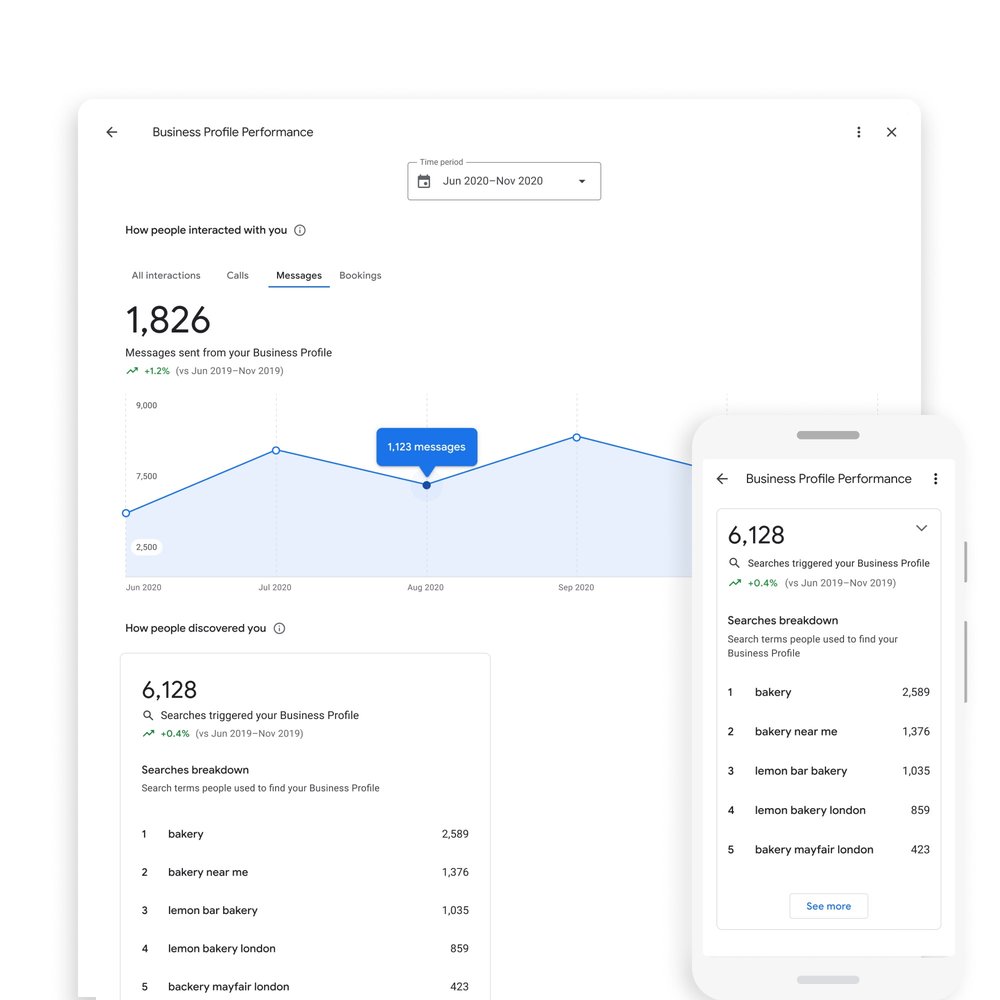
New performance metrics on Search and Maps show the key phrases people use to see your Business Profile
We’ve continued to invest in new ways to make it easier for you to bolster your presence on Google. With these updated features, we hope you have more of the tools and information you need to connect with customers and grow your business in today’s ever-changing environment.
Spruce up your Business Profile for holiday shoppers
by Rajas Moonka on Dec.02, 2020, under 3D Models, Argentina, Australia, Brazil, California, Denmark, England, Germany, Google Earth News, Google Earth Tips, Google Sky, Google maps, Hawaii, Indonesia, Ireland, Italy, Japan, Kenya, Mexico, Natural Landmarks, Netherlands, Sightseeing, Street Views, USA
The holidays can be the most hectic—and the most important—time of the year for business owners. And this year shoppers are flocking to online shopping and curbside pickups. To make the most of this season and connect with shoppers wherever they are, we have a recipe for holiday success. Here’s a list you’ll want to check twice:
1. Deck the halls of your Business Profile: First things first, claim your free Business Profile to put your best face forward on Google Maps and Search. Make sure your Business Profile is updated with helpful information about your store—like updated hours, a description and photos, shopping options, and all the safety measures you’re taking during the pandemic. Pro tip: Double check if your phone number is correct and turn on messaging so you can quickly connect with customers who have questions.
2. Share the gift of updated in-store inventory (online!): Unsurprisingly, 77 percent of holiday shoppers in the U.S. said they will browse for gift ideas online this year instead of in-store. Thanks to Pointy from Google, you can easily show your products online so shoppers can see what you carry before they head to the store to make a purchase. Pointy connects to your point-of-sale system and automatically adds your in-store products to your Business Profile on Google. This helps you to appear in search results when shoppers are looking for items you carry.
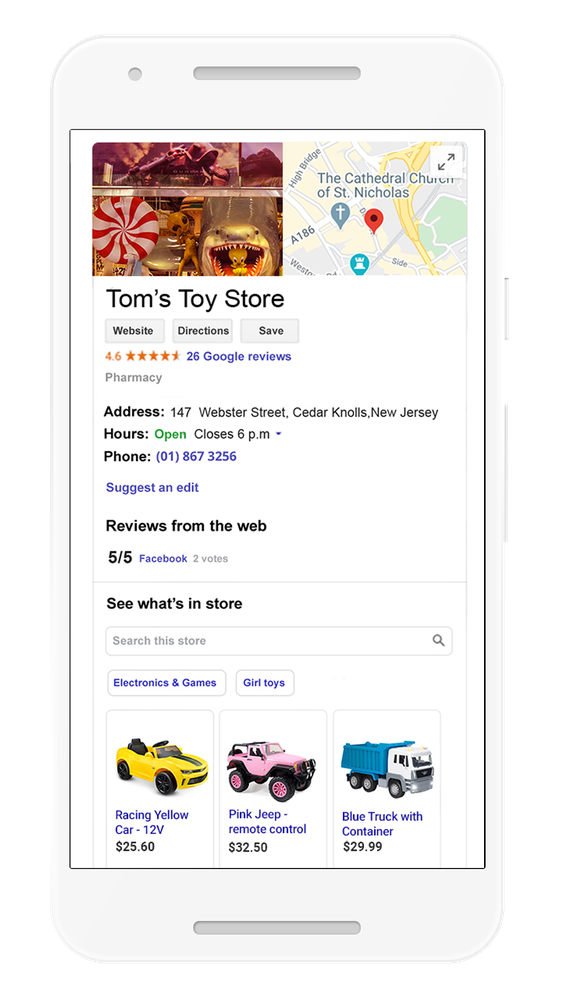
Pointy from Google automatically adds your inventory to your Business Profile and can help shoppers find you when they search for items you carry
3. Help them order ahead, still tucked in their beds: Searches for “curbside pickup” have grown more than 3,000 percentglobally since last year. Let customers know how they can shop with you—whether you’re offering curbside pickup, in-store pickup or delivery options.
4. Oh, what fun it is to buy online for pickup and delivery:Add ordering link(s) for pickup or delivery to your profile. If you’re a verified retail merchant in the U.S., you can now add a link to your online store directly to your Business Profile on Google. This helps shoppers easily place a pickup or delivery order from you with a few simple taps!
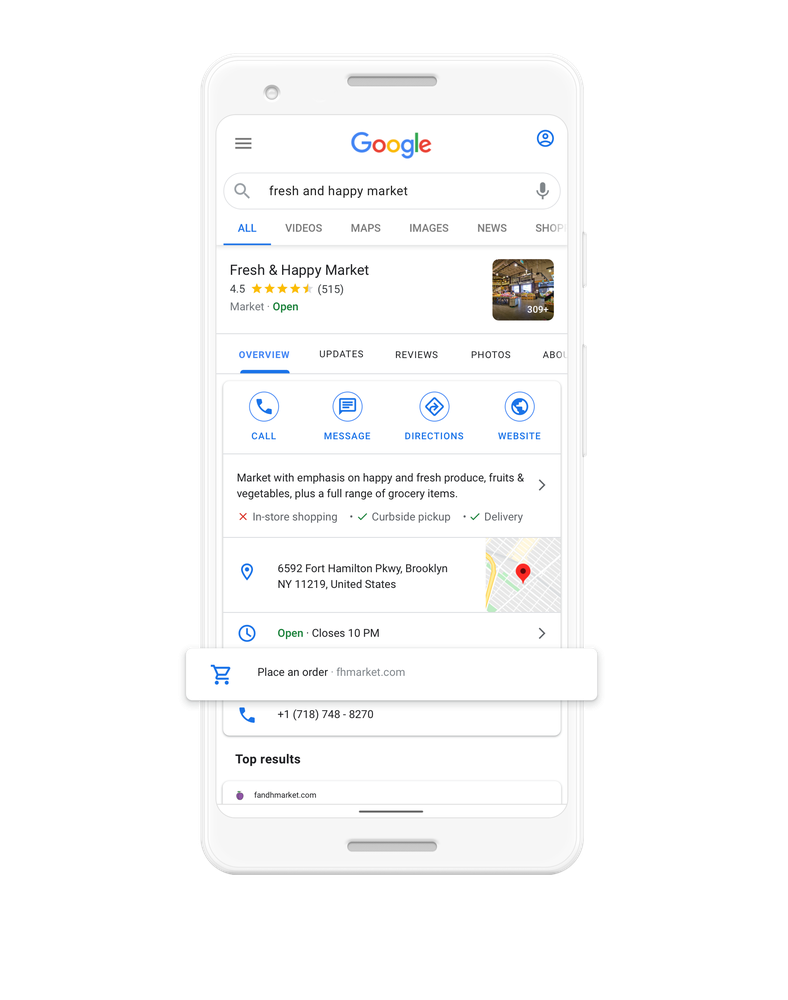
If you’re a verified business in the U.S., you can add a link to your online store so customers can easily place pickup and delivery orders
5. 'Tis the season to share more about your business: Shoppers are looking to purchase from local businesses that they feel good about supporting. Spruce up your Business Profile and connect with your community by showing whether you’re LGBTQ-friendly or women-led, or in the U.S. and identify as Black-owned or veteran-led.
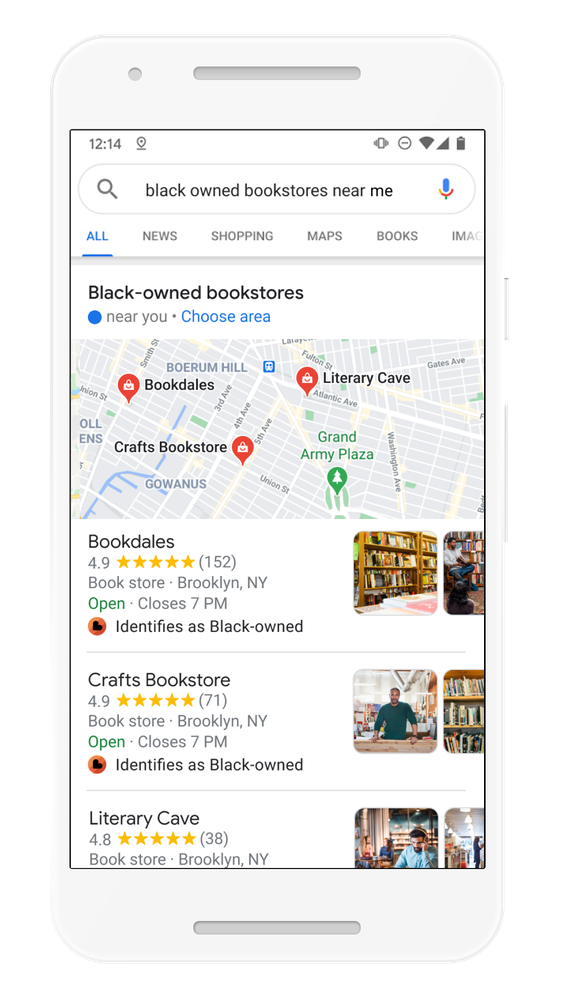
Share more about your business by adding attributes to your Business Profile.
For more ways to deck out your Google presence, check out Grow with Google’s Quick Help YouTube videos. The short videos will help answer a variety of small business questions, from how to make the most of digital tools to how to start a live stream. We know the holiday season can be overwhelming, but with this checklist in hand there will be no need to get your tinsel in a tangle.


